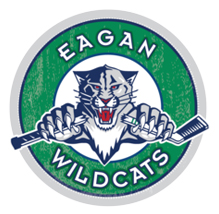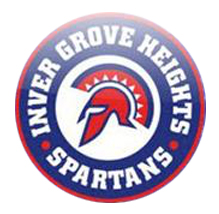Hockey Terms and Rules
New to Hockey?
New to hockey? Watching your child or grandchild and have no idea what is being said? Dont worry we have all been there before. Here at CGHA we have put together a list of some of the Terms and Rules used in hockey. Hopefully the lists you see below will help you understand what is being said and allow you to enjoy the game a little better. Thank you for your support of youth hockey and CGHA. Below you will find basic hockey info grouped into four (4) categories;
- Hockey Rink
- Hockey Positions
- Basic Terms
- Penalty Terms
Hockey Rink
 Blue Line
Blue Line
Two lines running across the width of the rink, one on either side of the red line. The area between the blue lines is called the neutral zone.
Red Line
The line that divides the rink into two equal parts. This area is center ice.
Goal Line
The red line which runs between the goal posts and extends in both directions to the side boards.
The Crease
The semi-circular area in front of each goal is called the crease. If any offensive player is in the goal crease when a goal is scored, the goal is not allowed. The crease is painted blue. The goal crease is designed to protect the goalies from interference by attacking players. The area marked on the ice in front of the penalty timekeeper's seat is for the use of the crease
Defensive Zone
When the other team is on the attack, the defensive zone is the area between your goal line and your blue line.
Neutral zone
The central ice area between the two blue lines (neither the defending nor the attacking zone).
Offensive Zone
When the your team is on the attack, the offensive zone is the area between blue line and your opponents goal.
Hockey Positions

Goalie
Perhaps the toughest position in all of sports, the goalie is the one player who can control a team’s confidence. His/Her job is to keep the puck out of the net, and if he’s good, he can take his team a long way. Good goalies win championships.
Defensemen
A team at full strength has two — one on the left side and another on the right. Nowadays, there are three primary kinds of defensemen. One is creative and offensive-minded; he/she likes to handle the puck and lead the team up ice, but is not too physical. Another is defensive-minded, a stay-at-home bruiser who plays a physical game and doesn’t often venture out of his zone with the puck. And there are those rare athletes who are a combination of the two.
Right wing
He/She works the right side of the ice for the most part. She/He needs to be a physical player who is good along the boards and in the corner. She/He is responsible for the opposition’s left defenseman in the defensive zone.
Left wing
Traditionally a left-handed shot, but the NHL is seeing more right-handers playing this position now, a practice picked up from the Europeans. A right-hander has a better angle to shoot from when he’s coming in on his wing. Like the right wing, he needs to be able to dig out the puck from the corners and battle in front of the net.
Center
He/She quarterbacks his club at both ends of the ice. Must be good at face-offs and passing, and it doesn’t hurt if he's/she's a good shot as well. Coaches want a lot of creativity in this position — and a lot of hockey smarts.
Basic Terms
Assist
An assist is awarded to the player or players (maximum of two) who touched the puck prior to the goal, provided no defender plays or possesses the puck in between.
Attacking Zone
When you are on the attack, your attacking zone is between your opponent's blue line and goal line.
Back Check
Forwards in their offensive zone skate back quickly to their own defensive zone to protect their goal and keep the opponent from shooting.
Blocker
For the goalie, the glove that goes on the hand that holds the stick.
Boarding
Violently checking an opponent into the boards from behind. Boarding is illegal and merits a penalty.
Boards
The wall around a hockey rink (which was at one time really made of wood but which is now usually of fiberglass) measuring about 42 inches high and topped off by synthetic glass to protect the spectators while giving them a good view of the action.
Body Check
A body check is where you use your body against an opponent who has possession of the puck. Legal body checking must be done only with the hips or shoulders and must be above the opponent's knees and below the neck. Unnecessarily rough body checking is penalized.
Box
A defensive alignment (similar to the diamond) often used by a team defending against a power play.
Breakaway
An offensive rush when there is no opponent between the puck carrier and the opposition's goalie.
Breakout
When the attacking team comes out of its defensive zone with the puck and starts up ice.
Penalty Terms
Boarding
Pushing an opponent violently into the boards while the player is facing the boards.
Charging
Taking more than three strides or jumping before hitting an opponent.
Checking from behind
Hitting an opponent from behind is a penalty. It carries an automatic minor penalty and misconduct, or a major penalty and game misconduct if it results in injury.
Cross-Checking
Hitting an opponent with the stick when it is held with two hands and no part of the stick is on the ice.
Elbowing
Hitting an opponent with the elbow
Fighting
Engaging in a physical altercation with an opposing player, usually involving the throwing of punches with gloves removed or worse. Minor altercations such as simple pushing and shoving, and punching with gloves still in place, are generally called as Roughing
Goaltender Interference
Physically impeding or checking the goaltender. Visually impeding the goaltender's view of the play with the body, called "screening", is legal; but at no time may a goaltender be hit or checked.
High-Sticking
Touching an opponent with the stick above shoulder level
Hooking
Using a stick as a hook to slow an opponent, no contact is required under new standards.
Slashing
Swinging a stick at an opponent, no contact is required under new standards
Too many men on the ice
Having more than the allowable number of players
Tripping
Using a stick or one's body to trip an opponent, no contact is required under new standards.


Stay connected
Follow the Wolfpack
 |
 |
 |
 |
 |
 |
 |
 |
 |
 |
 |
 |
Cottage Grove Hockey Association is a proud member and supporter of USA Hockey, Minnesota Hockey™, District 8 and follows the American Development Model (ADM)


